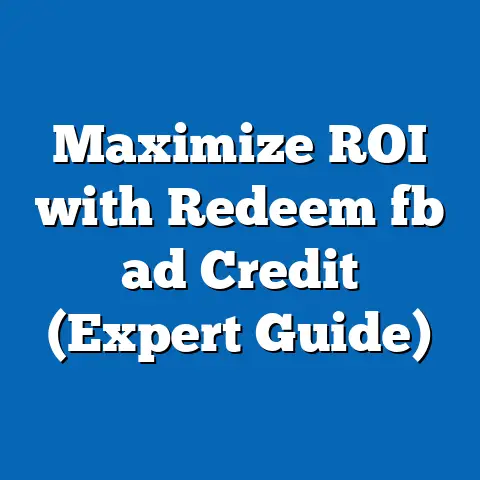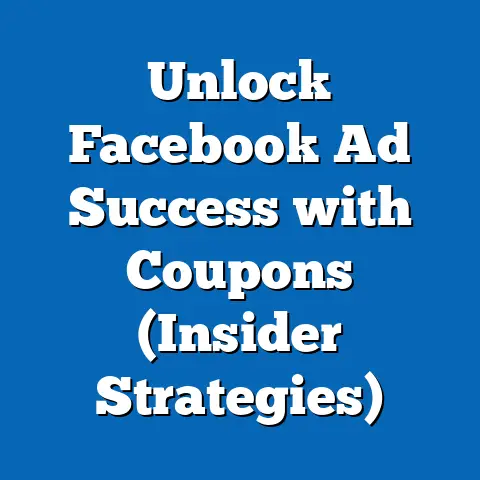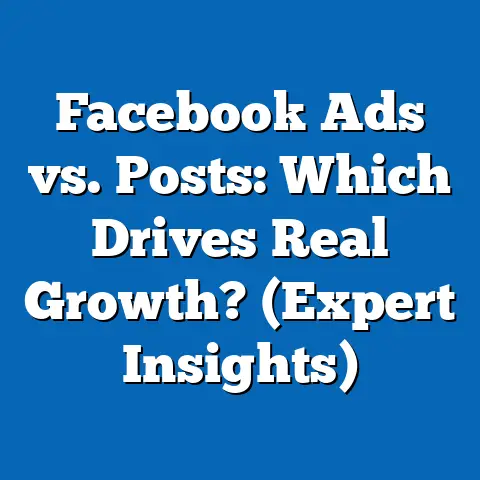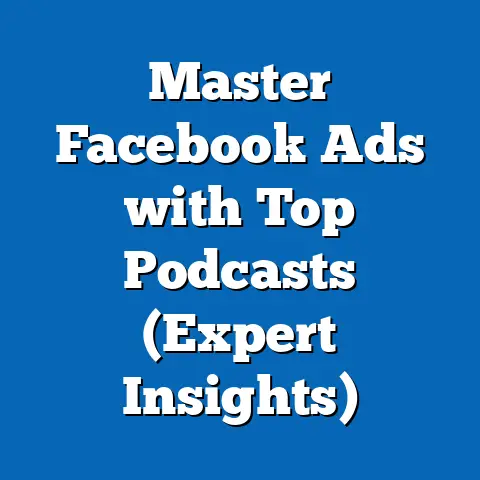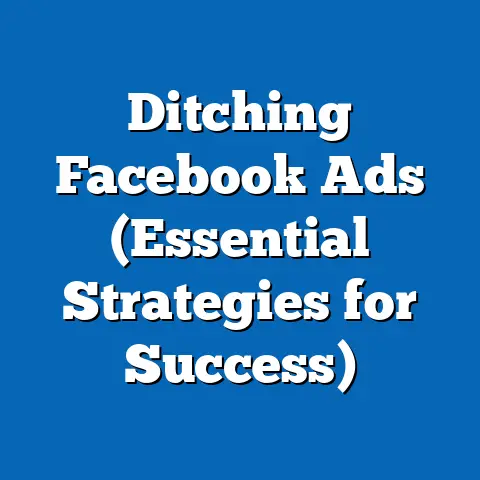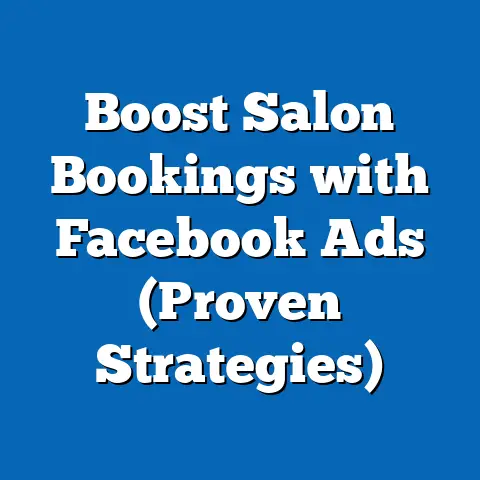Master Audience Editing for Facebook Ads (Pro Strategies)
Master Audience Editing for Facebook Ads: Pro Strategies to Elevate Your Campaigns
Imagine you’re a passionate entrepreneur. You’ve poured your heart, soul, and savings into your amazing product or service. You’re ready to share it with the world, so you create a Facebook ad campaign, meticulously crafting the perfect ad copy and selecting stunning visuals. You hit “publish,” eagerly anticipating a flood of new customers. Days turn into weeks, and…crickets. Your ad spend is dwindling, but your sales aren’t budging. The frustration is palpable, isn’t it?
I’ve been there, staring at the Ads Manager dashboard, feeling the sting of wasted ad dollars. But here’s the truth: the problem isn’t always the product or the ad creative. Often, it’s the audience. You might be showing your incredible offer to people who simply aren’t interested. This is where the art and science of audience editing come into play.
Mastering audience editing on Facebook isn’t just a technical skill; it’s a transformative practice. It empowers you to connect with your ideal customers more effectively, turning those frustrating moments into empowering victories. In this guide, I’ll share pro strategies to help you elevate your Facebook ad campaigns by targeting the right people, at the right time, with the right message.
Understanding the Importance of Audience Editing
So, what exactly do I mean by “audience editing”? In Facebook advertising, audience editing refers to the process of refining and optimizing your target audience to ensure that your ads are shown to the most relevant and receptive users. It’s about going beyond broad demographics and delving into the nuances of interests, behaviors, and connections to pinpoint those individuals who are most likely to engage with your ads and convert into customers.
Why is this so critical? Let’s break it down:
-
Better Engagement: Showing your ads to the right people means they are more likely to click, like, comment, and share your content. This increased engagement not only drives traffic to your website or landing page but also boosts your ad’s relevance score, ultimately lowering your costs.
-
Higher Conversion Rates: Relevance is key. When your ad resonates with the audience, they’re more likely to take the desired action, whether it’s making a purchase, signing up for a newsletter, or downloading a resource. The more relevant your ads, the higher your conversion rates will be.
-
Improved ROI: This is the bottom line. By targeting the right audience, you maximize the impact of your ad spend. You’re not wasting money showing ads to people who are unlikely to convert. Instead, you’re focusing your budget on those who are genuinely interested in what you have to offer, leading to a higher return on investment.
Better Engagement: Showing your ads to the right people means they are more likely to click, like, comment, and share your content. This increased engagement not only drives traffic to your website or landing page but also boosts your ad’s relevance score, ultimately lowering your costs.
Higher Conversion Rates: Relevance is key. When your ad resonates with the audience, they’re more likely to take the desired action, whether it’s making a purchase, signing up for a newsletter, or downloading a resource. The more relevant your ads, the higher your conversion rates will be.
Improved ROI: This is the bottom line. By targeting the right audience, you maximize the impact of your ad spend. You’re not wasting money showing ads to people who are unlikely to convert. Instead, you’re focusing your budget on those who are genuinely interested in what you have to offer, leading to a higher return on investment.
Let’s look at some numbers. According to a study by HubSpot, personalized ads deliver 6x higher transaction rates. Think about that for a second – six times! It underscores the undeniable power of effective audience targeting. Also, consider that retargeting ads, which are shown to users who have already interacted with your brand, have a click-through rate (CTR) that’s 10x higher than typical display ads, as reported by Retargeter. This illustrates the potential impact of precisely targeted ads.
I remember working with a small e-commerce brand that sold eco-friendly baby products. Initially, their ad campaigns targeted a broad audience of parents aged 25-45. While they saw some engagement, their conversion rates were dismal. After diving deep into audience editing, we discovered that their ideal customers were actually eco-conscious parents who were actively involved in organic food communities and followed sustainable living blogs. By narrowing their target audience to these specific interests and behaviors, their conversion rates skyrocketed by 300%!
Key Takeaway: Audience editing is not an optional extra; it’s the foundation of a successful Facebook advertising campaign. It allows you to connect with the right people, drive engagement, boost conversion rates, and ultimately maximize your ROI.
Identifying Your Ideal Audience
Now that you understand the importance of audience editing, let’s talk about how to actually identify your ideal audience. This is where the rubber meets the road, and it all starts with creating detailed buyer personas.
A buyer persona is a semi-fictional representation of your ideal customer, based on research and data about your existing and potential customers. It goes beyond basic demographics and delves into their motivations, goals, pain points, and behaviors. Think of it as creating a character profile for your perfect customer.
Why are buyer personas so crucial? Because they provide a clear picture of who you’re trying to reach. They help you understand what motivates your target audience, what challenges they face, and what type of messaging will resonate with them. This, in turn, informs your ad copy, visuals, and targeting strategy.
Here are some key demographic, psychographic, and behavioral factors to consider when defining your ideal audience:
-
Demographics: This includes basic information such as age, gender, location, education, income, and job title. While demographics are a good starting point, they don’t tell the whole story.
-
Psychographics: This delves into the psychological aspects of your audience, such as their values, interests, lifestyle, and personality. What are their hobbies? What are they passionate about? What are their beliefs? Understanding psychographics helps you craft ads that resonate with their core values and aspirations.
-
Behaviors: This focuses on how your audience interacts with your brand and the world around them. What websites do they visit? What social media platforms do they use? What purchases have they made in the past? Understanding behaviors helps you target users based on their online activity and purchase history.
Demographics: This includes basic information such as age, gender, location, education, income, and job title. While demographics are a good starting point, they don’t tell the whole story.
Psychographics: This delves into the psychological aspects of your audience, such as their values, interests, lifestyle, and personality. What are their hobbies? What are they passionate about? What are their beliefs? Understanding psychographics helps you craft ads that resonate with their core values and aspirations.
Behaviors: This focuses on how your audience interacts with your brand and the world around them. What websites do they visit? What social media platforms do they use? What purchases have they made in the past? Understanding behaviors helps you target users based on their online activity and purchase history.
For example, let’s say you’re selling high-end coffee beans. Your buyer persona might look something like this:
- Name: Emily
- Age: 35
- Location: Urban area
- Job Title: Marketing Manager
- Income: \$80,000/year
- Values: Quality, sustainability, ethical sourcing
- Interests: Coffee, gourmet food, travel, reading
- Lifestyle: Busy professional who appreciates the finer things in life
- Behaviors: Follows coffee blogs, visits specialty coffee shops, purchases organic food, shops online
With this persona in mind, you can craft ads that speak directly to Emily’s values, interests, and lifestyle. You might highlight the quality and ethical sourcing of your coffee beans, showcase stunning visuals of exotic coffee farms, and target users who follow coffee blogs or visit specialty coffee shops.
To gather data about your potential customers, I highly recommend using Facebook Audience Insights. This free tool provides valuable insights into the demographics, interests, and behaviors of people on Facebook. You can use it to explore different audience segments, identify potential targeting options, and gain a deeper understanding of your target audience.
I once used Audience Insights to help a client who sold organic skincare products. They thought their target audience was women aged 25-45 who were interested in beauty. However, after analyzing the data, we discovered that their ideal customers were actually women aged 30-50 who were interested in natural living, yoga, and organic food. By refining their target audience based on these insights, their ad performance improved dramatically.
Key Takeaway: Creating detailed buyer personas and utilizing tools like Facebook Audience Insights are essential for identifying your ideal audience. This allows you to craft ads that resonate with their values, interests, and behaviors, leading to better engagement, higher conversion rates, and improved ROI.
Audience Segmentation Strategies
Once you’ve identified your ideal audience, the next step is to segment them into smaller, more targeted groups. This allows you to tailor your ad messaging and visuals to specific segments, increasing the relevance and effectiveness of your campaigns. Here are some advanced audience segmentation strategies that can enhance your ad targeting:
-
Custom Audiences: Custom Audiences allow you to target people who have already interacted with your business, either online or offline. You can create Custom Audiences from your existing customer lists (email addresses, phone numbers), website visitors, app users, or people who have engaged with your Facebook page or ads.
-
Customer Lists: Uploading your customer list is a powerful way to target existing customers with specific offers or promotions. For example, you could target customers who haven’t made a purchase in the last six months with a special discount to encourage them to return.
-
Website Visitors: Targeting website visitors is a great way to retarget people who have shown interest in your products or services. You can create Custom Audiences based on specific pages they visited, time spent on your website, or actions they took (e.g., added items to their cart but didn’t complete the purchase).
-
Engagement: You can also target people who have engaged with your Facebook page or ads, such as liking your page, commenting on a post, or watching a video. This allows you to reach people who are already familiar with your brand and are more likely to convert.
-
-
Lookalike Audiences: Lookalike Audiences allow you to find new customers who are similar to your best existing customers. You can create a Lookalike Audience based on your Custom Audiences (e.g., your customer list, website visitors, or people who have engaged with your Facebook page). Facebook will then identify users who share similar demographics, interests, and behaviors with your source audience.
-
Seed Audience: The key to a successful Lookalike Audience is to use a high-quality seed audience. This should be a group of people who are highly valuable to your business, such as your top-spending customers or your most engaged users.
-
Audience Size: You can choose the size of your Lookalike Audience, ranging from 1% to 10% of the total population in your target country. A smaller percentage will result in a more precise match to your seed audience, while a larger percentage will result in a broader reach.
-
-
Detailed Targeting: Detailed Targeting allows you to refine your audience segments based on interests, behaviors, and demographics. This is where you can really get granular with your targeting.
-
Interests: Target users based on their interests, such as hobbies, passions, and topics they follow on Facebook.
-
Behaviors: Target users based on their online activity and purchase history, such as their purchase behavior, device usage, and travel habits.
-
Demographics: Target users based on their demographic information, such as age, gender, location, education, and job title.
-
Custom Audiences: Custom Audiences allow you to target people who have already interacted with your business, either online or offline. You can create Custom Audiences from your existing customer lists (email addresses, phone numbers), website visitors, app users, or people who have engaged with your Facebook page or ads.
-
Customer Lists: Uploading your customer list is a powerful way to target existing customers with specific offers or promotions. For example, you could target customers who haven’t made a purchase in the last six months with a special discount to encourage them to return.
-
Website Visitors: Targeting website visitors is a great way to retarget people who have shown interest in your products or services. You can create Custom Audiences based on specific pages they visited, time spent on your website, or actions they took (e.g., added items to their cart but didn’t complete the purchase).
-
Engagement: You can also target people who have engaged with your Facebook page or ads, such as liking your page, commenting on a post, or watching a video. This allows you to reach people who are already familiar with your brand and are more likely to convert.
Customer Lists: Uploading your customer list is a powerful way to target existing customers with specific offers or promotions. For example, you could target customers who haven’t made a purchase in the last six months with a special discount to encourage them to return.
Website Visitors: Targeting website visitors is a great way to retarget people who have shown interest in your products or services. You can create Custom Audiences based on specific pages they visited, time spent on your website, or actions they took (e.g., added items to their cart but didn’t complete the purchase).
Engagement: You can also target people who have engaged with your Facebook page or ads, such as liking your page, commenting on a post, or watching a video. This allows you to reach people who are already familiar with your brand and are more likely to convert.
Lookalike Audiences: Lookalike Audiences allow you to find new customers who are similar to your best existing customers. You can create a Lookalike Audience based on your Custom Audiences (e.g., your customer list, website visitors, or people who have engaged with your Facebook page). Facebook will then identify users who share similar demographics, interests, and behaviors with your source audience.
-
Seed Audience: The key to a successful Lookalike Audience is to use a high-quality seed audience. This should be a group of people who are highly valuable to your business, such as your top-spending customers or your most engaged users.
-
Audience Size: You can choose the size of your Lookalike Audience, ranging from 1% to 10% of the total population in your target country. A smaller percentage will result in a more precise match to your seed audience, while a larger percentage will result in a broader reach.
Seed Audience: The key to a successful Lookalike Audience is to use a high-quality seed audience. This should be a group of people who are highly valuable to your business, such as your top-spending customers or your most engaged users.
Audience Size: You can choose the size of your Lookalike Audience, ranging from 1% to 10% of the total population in your target country. A smaller percentage will result in a more precise match to your seed audience, while a larger percentage will result in a broader reach.
Detailed Targeting: Detailed Targeting allows you to refine your audience segments based on interests, behaviors, and demographics. This is where you can really get granular with your targeting.
-
Interests: Target users based on their interests, such as hobbies, passions, and topics they follow on Facebook.
-
Behaviors: Target users based on their online activity and purchase history, such as their purchase behavior, device usage, and travel habits.
-
Demographics: Target users based on their demographic information, such as age, gender, location, education, and job title.
Interests: Target users based on their interests, such as hobbies, passions, and topics they follow on Facebook.
Behaviors: Target users based on their online activity and purchase history, such as their purchase behavior, device usage, and travel habits.
Demographics: Target users based on their demographic information, such as age, gender, location, education, and job title.
I recall working with a fashion boutique that was struggling to attract new customers. We started by creating a Custom Audience of their existing customers and then used that audience to create a Lookalike Audience. We also used Detailed Targeting to target users who were interested in fashion, shopping, and specific clothing brands. By combining these strategies, they were able to significantly expand their reach and attract a flood of new customers.
Testing different audience segments is crucial for optimal performance. You can use Facebook’s A/B testing feature to compare the performance of different audiences and identify the most effective targeting options. I recommend testing different combinations of Custom Audiences, Lookalike Audiences, and Detailed Targeting to see what works best for your business.
Key Takeaway: Advanced audience segmentation strategies, such as Custom Audiences, Lookalike Audiences, and Detailed Targeting, can significantly enhance your ad targeting. By segmenting your audience into smaller, more targeted groups, you can tailor your ad messaging and visuals to specific segments, increasing the relevance and effectiveness of your campaigns.
The Art of Exclusion
While targeting the right audience is essential, excluding the wrong audience is equally important. Audience exclusion is the process of excluding certain demographics or audiences that are unlikely to convert, thus saving ad spend and improving the overall performance of your campaigns.
Why is audience exclusion so important? Because it prevents you from wasting money showing ads to people who are not interested in your products or services. It also helps you refine your targeting and focus your budget on those who are most likely to convert.
Here are some strategies for excluding certain demographics or audiences:
-
Existing Customers: If you’re running ads to acquire new customers, you may want to exclude your existing customers from your targeting. This prevents you from showing ads to people who have already purchased your products or services.
-
Employees: Excluding your employees is another way to save ad spend. You don’t want to show ads to people who already work for your company.
-
Competitors: You may also want to exclude people who work for your competitors. This prevents them from seeing your ads and potentially stealing your marketing strategies.
-
Irrelevant Demographics: If your products or services are only relevant to a specific demographic, you should exclude other demographics from your targeting. For example, if you’re selling products for women, you should exclude men from your targeting.
-
Low-Performing Audiences: If you’ve identified certain audiences that are consistently underperforming, you should exclude them from your targeting. This allows you to focus your budget on audiences that are more likely to convert.
Existing Customers: If you’re running ads to acquire new customers, you may want to exclude your existing customers from your targeting. This prevents you from showing ads to people who have already purchased your products or services.
Employees: Excluding your employees is another way to save ad spend. You don’t want to show ads to people who already work for your company.
Competitors: You may also want to exclude people who work for your competitors. This prevents them from seeing your ads and potentially stealing your marketing strategies.
Irrelevant Demographics: If your products or services are only relevant to a specific demographic, you should exclude other demographics from your targeting. For example, if you’re selling products for women, you should exclude men from your targeting.
Low-Performing Audiences: If you’ve identified certain audiences that are consistently underperforming, you should exclude them from your targeting. This allows you to focus your budget on audiences that are more likely to convert.
I once worked with a local restaurant that was running ads to promote their lunch specials. Initially, they were targeting a broad audience of people who lived within a 5-mile radius of the restaurant. However, after analyzing their ad performance, we discovered that people who lived in certain neighborhoods were consistently underperforming. By excluding these neighborhoods from their targeting, they were able to significantly improve their ad performance and reduce their ad spend.
Audience exclusion can lead to improved ad performance in several ways:
-
Reduced Ad Spend: By excluding irrelevant audiences, you can save money on your ad spend and focus your budget on those who are most likely to convert.
-
Improved Relevance Score: Showing your ads to a more targeted audience can improve your ad’s relevance score, which can lower your costs and increase your ad’s visibility.
-
Higher Conversion Rates: By excluding irrelevant audiences, you can increase your conversion rates and improve the overall performance of your campaigns.
Reduced Ad Spend: By excluding irrelevant audiences, you can save money on your ad spend and focus your budget on those who are most likely to convert.
Improved Relevance Score: Showing your ads to a more targeted audience can improve your ad’s relevance score, which can lower your costs and increase your ad’s visibility.
Higher Conversion Rates: By excluding irrelevant audiences, you can increase your conversion rates and improve the overall performance of your campaigns.
Key Takeaway: Audience exclusion is a crucial aspect of Facebook advertising. By excluding certain demographics or audiences that are unlikely to convert, you can save ad spend, improve your ad’s relevance score, and increase your conversion rates.
A/B Testing Your Audience Edits
A/B testing, also known as split testing, is the process of comparing two versions of an ad (or audience) to see which one performs better. In the context of audience editing, A/B testing involves testing different audience segments to determine which one is most effective at driving engagement, conversions, and ROI.
Why is A/B testing so important? Because it allows you to make data-driven decisions about your audience targeting. Instead of relying on guesswork or intuition, you can use A/B testing to identify the most effective audience segments and optimize your campaigns for maximum performance.
Here’s a step-by-step guide on how to set up A/B tests to determine the effectiveness of different audience segments:
-
Define Your Hypothesis: Before you start testing, it’s important to define your hypothesis. What audience segments do you want to test? What do you expect to happen? For example, you might hypothesize that targeting users who are interested in both coffee and travel will result in higher conversion rates than targeting users who are only interested in coffee.
-
Create Two Audience Segments: Create two audience segments that you want to compare. These segments should be similar in size and demographics, but they should differ in one key aspect (e.g., interests, behaviors, or demographics).
-
Create Two Ads: Create two ads that are identical in every way except for the audience targeting. Make sure that your ads are relevant to both audience segments.
-
Set Up Your A/B Test: In Facebook Ads Manager, create a new campaign and select the “A/B Test” objective. Follow the prompts to set up your test, choosing your two audience segments and your two ads.
-
Set Your Budget and Schedule: Set your budget and schedule for your A/B test. Make sure that you allocate enough budget to each audience segment to get statistically significant results.
-
Track Your Results: Monitor your A/B test closely and track key metrics such as impressions, clicks, click-through rate (CTR), conversion rate, and cost per acquisition (CPA).
-
Analyze Your Results: After your A/B test has run for a sufficient amount of time (at least a week), analyze your results. Which audience segment performed better? Was your hypothesis correct?
-
Implement Your Findings: Based on your A/B test results, implement your findings in your ad campaigns. Focus your budget on the audience segments that are performing best and optimize your ads for maximum performance.
Define Your Hypothesis: Before you start testing, it’s important to define your hypothesis. What audience segments do you want to test? What do you expect to happen? For example, you might hypothesize that targeting users who are interested in both coffee and travel will result in higher conversion rates than targeting users who are only interested in coffee.
Create Two Audience Segments: Create two audience segments that you want to compare. These segments should be similar in size and demographics, but they should differ in one key aspect (e.g., interests, behaviors, or demographics).
Create Two Ads: Create two ads that are identical in every way except for the audience targeting. Make sure that your ads are relevant to both audience segments.
Set Up Your A/B Test: In Facebook Ads Manager, create a new campaign and select the “A/B Test” objective. Follow the prompts to set up your test, choosing your two audience segments and your two ads.
Set Your Budget and Schedule: Set your budget and schedule for your A/B test. Make sure that you allocate enough budget to each audience segment to get statistically significant results.
Track Your Results: Monitor your A/B test closely and track key metrics such as impressions, clicks, click-through rate (CTR), conversion rate, and cost per acquisition (CPA).
Analyze Your Results: After your A/B test has run for a sufficient amount of time (at least a week), analyze your results. Which audience segment performed better? Was your hypothesis correct?
Implement Your Findings: Based on your A/B test results, implement your findings in your ad campaigns. Focus your budget on the audience segments that are performing best and optimize your ads for maximum performance.
During A/B tests, it’s important to track several key metrics to determine the effectiveness of different audience segments. These metrics include:
- Impressions: The number of times your ad was shown to users.
- Clicks: The number of times users clicked on your ad.
- Click-Through Rate (CTR): The percentage of impressions that resulted in clicks.
- Conversion Rate: The percentage of clicks that resulted in conversions (e.g., purchases, sign-ups, downloads).
- Cost Per Acquisition (CPA): The cost of acquiring a new customer through your ad campaign.
I once used A/B testing to help a client who was selling online courses. They wanted to know whether it was more effective to target users who were interested in specific course topics or users who were interested in general career development. We created two audience segments, one targeting users who were interested in specific course topics (e.g., web design, marketing, coding) and the other targeting users who were interested in general career development. After running an A/B test, we discovered that targeting users who were interested in specific course topics resulted in significantly higher conversion rates. Based on these results, we shifted our budget to focus on this audience segment, which led to a significant increase in sales.
Key Takeaway: A/B testing is a powerful tool for optimizing your audience targeting. By testing different audience segments and tracking key metrics, you can identify the most effective targeting options and maximize the performance of your Facebook ad campaigns.
Conclusion
Mastering audience editing on Facebook is not just about understanding the technical aspects of the platform; it’s about understanding your customers. It’s about empathizing with their needs, anticipating their desires, and crafting ads that resonate with their values and aspirations.
I’ve shared a lot of information in this guide, but the most important thing to remember is that audience editing is an ongoing process. It’s not a one-time task that you can check off your list. It’s a continuous cycle of testing, learning, and refining.
So, take action. Experiment with the strategies I’ve discussed. Create detailed buyer personas, segment your audience, exclude irrelevant demographics, and A/B test your audience edits. Envision the success that better-targeted Facebook ads can bring to your business. Imagine the increased engagement, the higher conversion rates, and the improved ROI.
Remember that feeling of frustration I described at the beginning of this guide? The feeling of watching your ad spend evaporate with little to show for it? You don’t have to feel that way anymore. By mastering audience editing, you can transform your Facebook advertising efforts from disheartening to empowering.

